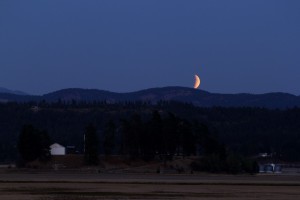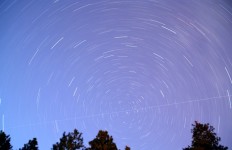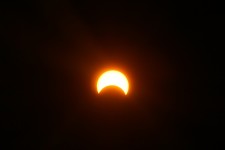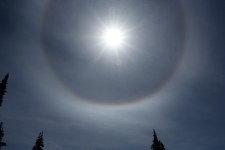As the full moon rose after sunset on Sunday, Sept. 27, observers were treated to a partial lunar eclipse. As the moon climbed higher in the sky, the bright crescent became smaller and the rest of the moon became redder as it progressed to a total lunar eclipse.
Lunar eclipses only happen when the sun, Earth and moon are perfectly lined up so the moon passes through the Earth’s shadow. This alignment, called syzygy, usually happens twice a year because the moon’s orbit around Earth is tilted compared to Earth’s orbit around the sun. The five degree tilt causes the moon to miss Earth’s shadow during other full moons.
When the perfect alignment occurs, a total lunar eclipse doesn’t always happen–sometimes a partial eclipse occurs and sometimes a penumbral eclipse.
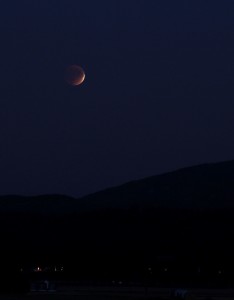
During a total lunar eclipse, the moon doesn’t completely disappear because some sunlight passes through Earth’s atmosphere and is refracted and refocused on the moon.
The Earth’s shadow has two parts: the umbra and the penumbra. The umbra is the full, dark shadow and the penumbra is the lighter outer shadow. A partial eclipse occurs when the moon passes through part of the umbra and the Earth’s dark shadow covers only part of the moon. During a penumbral eclipse the moon is in the Earth’s faint outer shadow and the slight color change is only noticed by seasoned skywatchers.
This last eclipse was the end to a unique astronomical phenomenon–a lunar tetrad. Lunar tetrads occur when four total lunar eclipses occur in a row without partial eclipses in between. The four total eclipses in this tetrad were on April 14, 2014, Oct. 7, 2014, April 4, 2015 and Sept. 27, 2015.
Lunar tetrads don’t occur at regular intervals. The last lunar tetrad was in 2003-2004 and the next tetrad is in 2032-2033. There will be eight tetrads from 2001 to 2100. Prior to 2001, there were 54 tetrads since AD 1 and none occurred between 1600 and 1900.
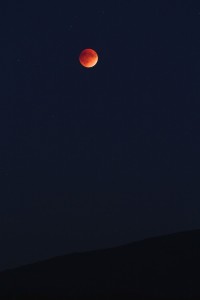
In any geographic location, there is an average of one total lunar eclipse every 2.3 years whereas the same location sees a total solar eclipse once every 375 years.
The release of a book in 2013 caused the moons in a lunar tetrad to be coined “blood moons”. Astronomers haven’t used the term in regards to lunar tetrads. The term blood moon may be familiar in reference to the full moon after the Harvest Moon which is called the Hunter’s Moon or Blood Moon.
During a total lunar eclipse the moon can turn a blood red color but not always–sometimes the moon turns grey, brown or orange. The color and brightness cannot be predicted because it is a result of global weather and dust in the atmosphere. A clear atmosphere (minimal weather) results in a bright lunar eclipse. A very dark eclipse occurs when there are lots of particles in the atmosphere such as from a volcanic eruption during the last few years.
Lunar eclipses tend to be on the red end of the color spectrum because red light isn’t scattered when traveling through the atmosphere like other colors. Thus the red color of an eclipse is the result of all the sunrises and sunsets being cast onto the moon as that is the only light that is available to be bent towards the moon.
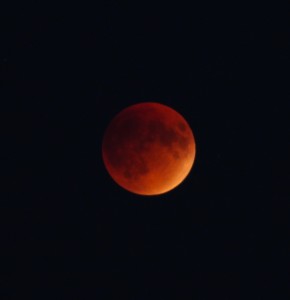
When a total lunar eclipse occurs, the temperature on the moon’s surface can suddenly drop over 300 degrees Fahrenheit.
The recent lunar eclipse may have seemed bright not because of clear global weather but because of the moon’s position to Earth. The total lunar eclipse coincided with the moon being at its closest point (perigee) to Earth in its elliptical orbit, thus appearing larger and brighter. A full moon occurring at the perigee is called a “supermoon”. The moon is only 222,000 miles from the Earth versus the 252,000 miles at its farther point in orbit causing the full moon to appear 30 percent brighter and up to 14 percent larger than at its farther point.
“Supermoon” total eclipses don’t happen often. The last “supermoon” total eclipse occurred in 1982 and the next one will occur in 2033. However, the next total lunar eclipse will occur on the morning of Jan. 31, 2018. Next year’s lunar eclipses are penumbral eclipses so they won’t be as spectacular as the recent “supermoon” total lunar eclipse.

